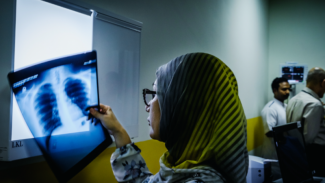
In the Western Pacific Region, 23% of incident TB cases are estimated to be unreached, undiagnosed or unreported in 2019. Countries and areas are intensifying their efforts to conduct systematic screening for TB disease in high-risk groups to ensure early diagnosis of all people with TB.
The most desirable screening strategy is one with high total yield of true-positive TB cases, few false-positives, low number needed to screen (to detect a true case), low cost, a rapid and simple algorithm and high client acceptability. In practice, many of these factors can run in opposite directions, and multifactorial analysis is required.
Screen-TB is a web-based tool to assist TB program managers and implementation partners in the design of TB screening programmes. It enables comparisons of different TB screening methods that could be applied in a given country, or applied to different risk groups at the national or subnational levels. The tool also includes graphics to illustrate the risk of false- positive diagnoses for screening, specific to the risk of TB in the group being screened and the accuracy of the screening algorithm being used. It enables program managers to assess the expected cost and effectiveness, and risks and benefits, of potential approaches.